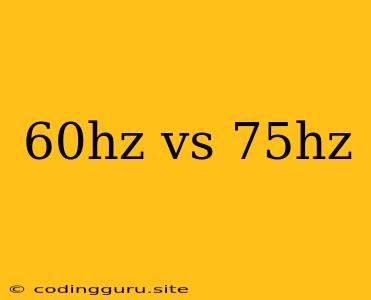60Hz vs 75Hz: Which Refresh Rate Is Right for You?
In the realm of gaming and digital displays, refresh rate has become a crucial factor in determining visual fluidity and responsiveness. Two common refresh rates, 60Hz and 75Hz, often leave users pondering which one to choose.
What are 60Hz and 75Hz?
Refresh rate, measured in Hertz (Hz), refers to the number of times a monitor's screen refreshes per second. A 60Hz display refreshes 60 times every second, while a 75Hz display refreshes 75 times every second.
Why does refresh rate matter?
Higher refresh rates translate to smoother and more responsive visuals, especially in fast-paced scenarios like gaming. This is because the screen updates more frequently, reducing motion blur and tearing, leading to a more enjoyable and immersive experience.
60Hz vs. 75Hz: The Difference
While both 60Hz and 75Hz refresh rates are relatively common, there's a noticeable difference in performance, especially during demanding tasks like gaming. A 75Hz monitor refreshes 25% more often than a 60Hz monitor, resulting in a smoother and more responsive visual experience.
Is 75Hz a significant upgrade over 60Hz?
For casual users and everyday tasks like web browsing and document editing, the difference between 60Hz and 75Hz might not be noticeable. However, gamers and those who appreciate smoother visuals will definitely appreciate the smoother animations and reduced motion blur on a 75Hz display.
When is 75Hz worth considering?
Here are some scenarios where a 75Hz display can be a worthwhile investment:
- Gaming: Gamers, especially those who play fast-paced action games, will benefit from the smoother gameplay and reduced input lag offered by a 75Hz display.
- Video Editing: While video editing doesn't require super high refresh rates, a 75Hz display can still offer a more responsive and fluid workflow.
- General Content Consumption: Even for everyday tasks like watching videos and browsing the web, a 75Hz display can provide a smoother and more enjoyable experience.
Are there drawbacks to 75Hz?
The main drawback of 75Hz is that it may not be as readily available as 60Hz displays. Additionally, 75Hz monitors can sometimes be slightly more expensive than their 60Hz counterparts.
60Hz vs. 75Hz: The Bottom Line
If you're looking for a budget-friendly option and don't mind slightly less smooth visuals, a 60Hz display is perfectly fine. However, if you're a gamer or value smooth visuals, a 75Hz display offers a noticeable improvement in fluidity and responsiveness.
Choosing the Right Refresh Rate:
Ultimately, the choice between 60Hz and 75Hz depends on your individual needs and budget. If you're on a tight budget or don't mind slightly less smooth visuals, a 60Hz display will suffice. But if you prioritize smooth visuals and have the budget for it, a 75Hz display will provide a more enjoyable and immersive experience.
Conclusion:
While both 60Hz and 75Hz offer decent performance, 75Hz provides a noticeable upgrade in smoothness and responsiveness, especially for gamers and those who appreciate fluid visuals. Consider your needs and budget when deciding which refresh rate is right for you.
